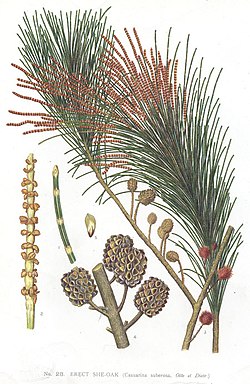| Allocasuarina | |
|---|---|
 | |
| Allocasuarina decaisneana in Central Australia | |
| Scientific classification | |
| Kingdom: | Plantae |
| Clade: | Tracheophytes |
| Clade: | Angiosperms |
| Clade: | Eudicots |
| Clade: | Rosids |
| Order: | Fagales |
| Family: | Casuarinaceae |
| Genus: | Allocasuarina L.A.S.Johnson [1] |
| Type species | |
| Allocasuarina torulosa (Aiton) L.A.S.Johnson [2] [3] | |
| Species | |
61 species; see text. | |


Allocasuarina, commonly known as sheoak [4] or she-oak, [5] is a genus of flowering plants in the family Casuarinaceae and is endemic to Australia. Plants in the genus Allocasuarina are trees or shrubs with soft, pendulous, green branchlets, the leaves reduced to scale-like teeth. Allocasuarinas are either monoecious or dioecious, the flowers never bisexual. Male and female flowers are arranged in spikes, the female spikes developing into cone-like structures enclosing winged seeds.
Contents
The genera Allocasuarina and Casuarina are similar, and many formerly in the latter now included in Allocasuarina.